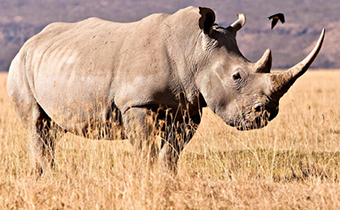Biodiversity & Environment
World Rhino Day
- 22 Sep 2021
- 3 min read
Why in News
World Rhino Day is observed on 22th September to spread awareness for all five species of rhino and work being done to save them.
Key Points
- It was first announced by the World Wildlife Fund (WWF) - South Africa in 2010. The species of rhinoceros are on the verge of extinction due to persistent poaching and habitat loss over several decades.
- There are five species of rhino – white and black rhinos in Africa, and the greater one-horned, Javan and Sumatran rhino species in Asia.
- IUCN Red List Status:
- White Rhino: Near Threatened.
- Black Rhino: Critically endangered.
- Greater One Horned: Vulnerable.
- Javan: Critically Endangered
- Sumatran Rhino: Critically Endangered
- IUCN Red List Status:
- Theme 2021: Keep the five Alive.
- Objectives: Strengthening protection, Expanding the distribution range, Research and monitoring, Adequate and sustained funding.
Greater One-Horned Rhinoceros
- About:
- Also known as Indian rhino, it is the largest of the rhino species. It is identified by a single black horn and a grey-brown hide with skin folds. India is home to the largest number of Greater One-Horned Rhinoceros in the world.
- They primarily graze, with a diet consisting almost entirely of grasses as well as leaves, branches of shrubs and trees, fruit, and aquatic plants.
- At present, there are about 2,600 Indian rhinos in India, with more than 90% of the population concentrated in Assam’s Kaziranga National Park.
- Habitat:
- The species is restricted to small habitats in Indo-Nepal terai and northern West Bengal and Assam.
- In India, rhinos are mainly found in Kaziranga NP, Pobitora WLS, Orang NP, Manas NP in Assam, Jaldapara NP and Gorumara NP in West Bengal and Dudhwa TR in Uttar Pradesh.
- Threats:
- Poaching for the horns
- Habitat loss
- Population density
- Decreasing Genetic diversity
- Protection Status:
- IUCN Red List: Vulnerable.
- CITES: Appendix-I
- Wildlife Protection Act, 1972: Schedule I.
- Conservation Efforts by India:
- New Delhi Declaration on Asian Rhinos 201’: India, Bhutan, Nepal, Indonesia and Malaysia have signed a declaration for the conservation and protection of the species.
- DNA profiles of all rhinos: The project will help in curbing poaching and gathering evidence in wildlife crimes involving rhinos.
- National Rhino Conservation Strategy: It was launched in 2019 to conserve the greater one-horned rhinoceros.
- Indian Rhino Vision 2020: It was an ambitious effort to attain a wild population of at least 3,000 greater one-horned rhinos spread over seven protected areas in the Indian state of Assam by the year 2020.





